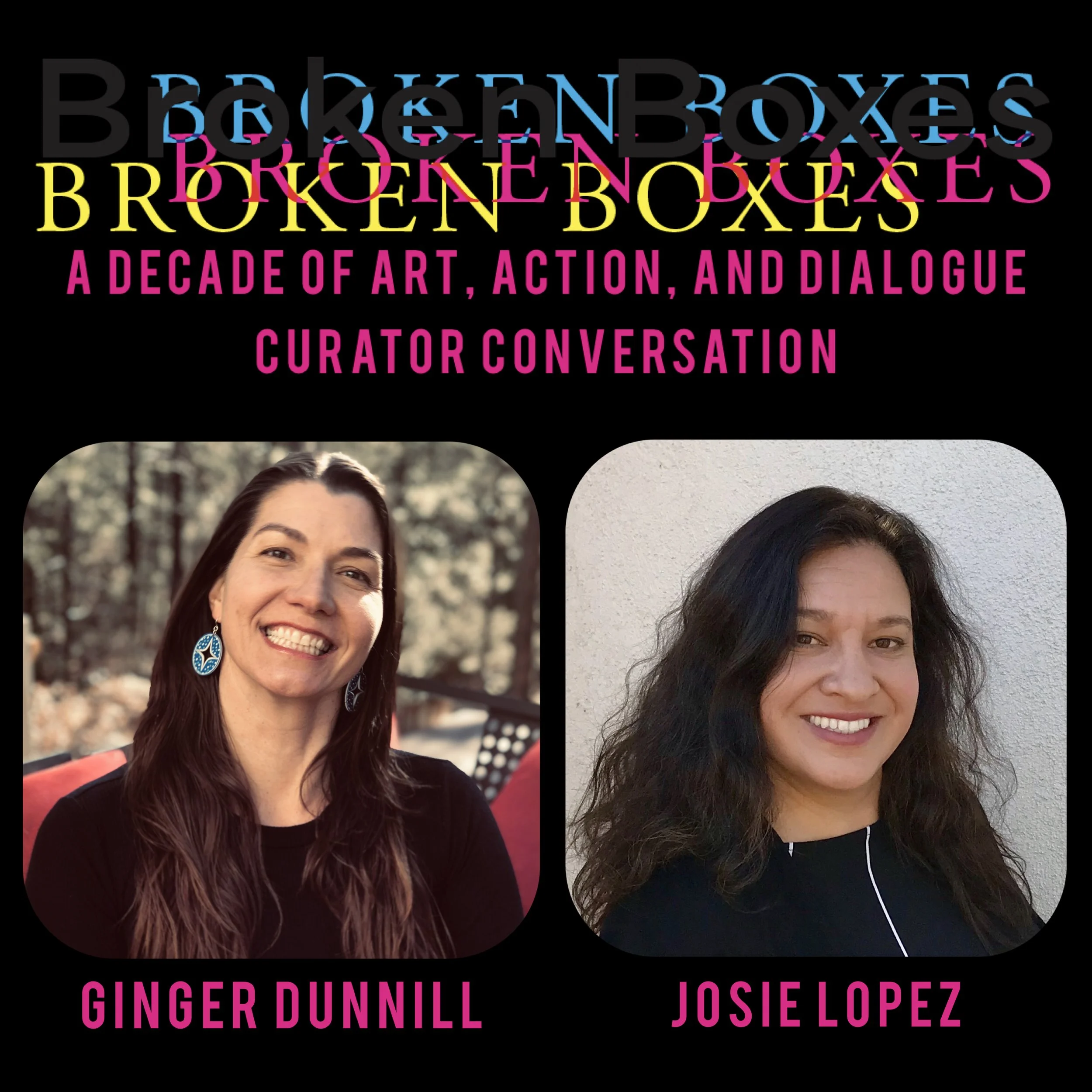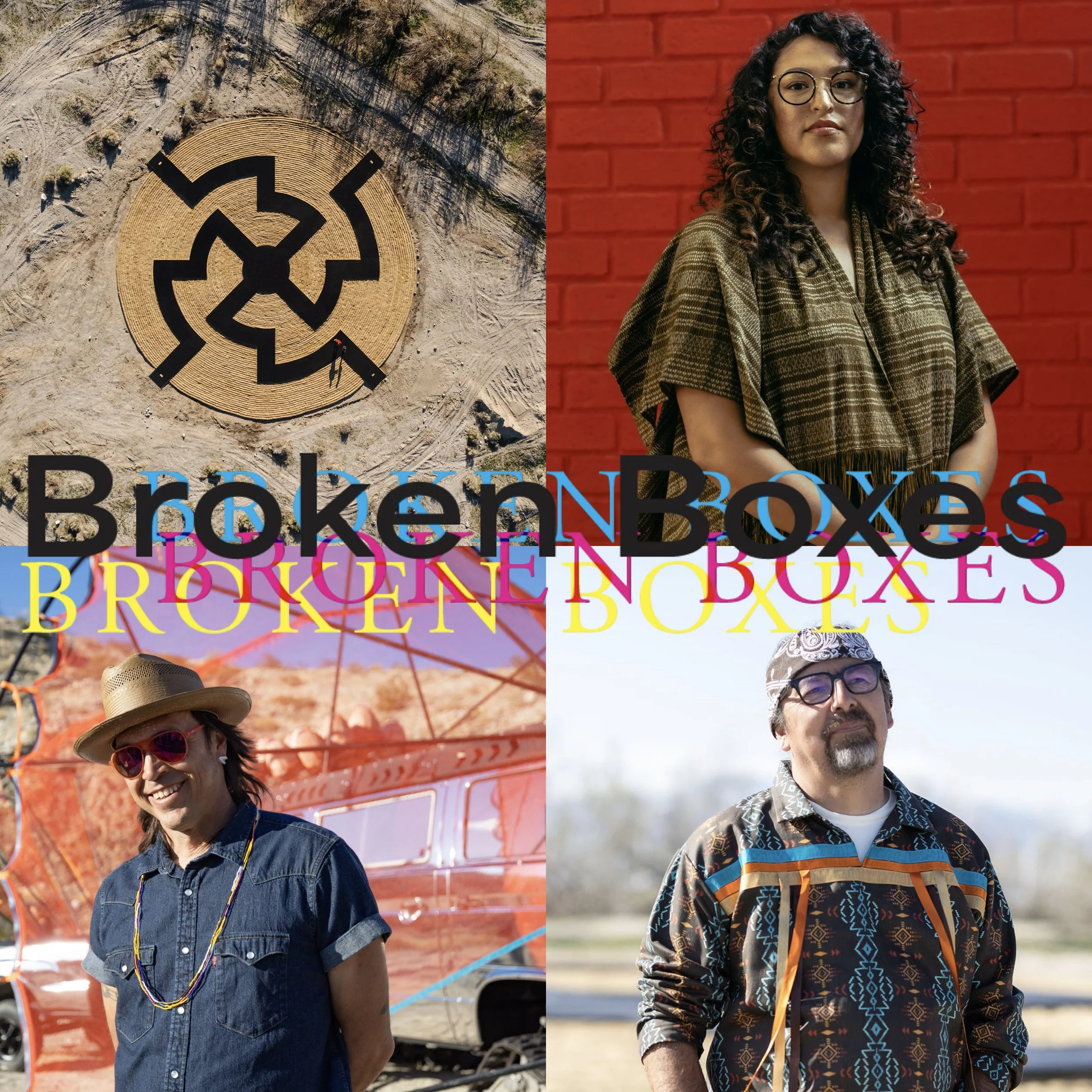This live conversation features artists Gerald Clarke and Cannupa Hanska Luger and Desert X Co-curator Kaitlin Garcia-Maestas and took place March 29, 2025 at the Thompson Hotel in Palm Springs, CA as a part of the Desert X 2025 program.
Gerald Clarke is a visual artist, educator, tribal leader, and cultural practitioner whose family has lived in the Anza Valley for time immemorial. Gerald was a featured artist in Desert X 2023 and presented “Immersion”, a monumental artwork based on Cahuilla basket weaving knowledge while also embedding a game-like quality to the installation in order to educate our current generations on Indigenous knowledge and language of the region.
Cannupa Hanska Luger is a multi-disciplinary artist and recurring host for Broken Boxes Podcast. Cannupa is featured in Desert X 2025, presenting a multi-pronged project titled G.H.O.S.T. Ride (Generative Habitation Operating System Technology), an evolving speculative fiction project which includes a mobile art installation, a poetic billboard triptic, and a new short film building upon ideas from his Future Ancestral Technologies series.
This lively discussion between these two Indigenous artists unfolds reflections around land ownership, maintenance of culture and respect for place. Both Gerald and Cannupa have exhibited for Desert X, yet each chose different paths towards sharing their Indigenous views through their projects. Desert X Co-Curator Kaitlin Garcia-Maestas thoughtfully guides the conversation into deep considerations around what it means to create public art in an accessible way, where the audience is left to interpret the artist's ideas on their own terms and in their own time. As Desert X Artistic Director Neville Wakefield notes in the introduction to this conversation, “ Desert X operates on the legacy of Land Art, and one of the questions that legacy leaves unanswered is—‘whose land is it and what are our responsibilities to it?’.
More about the panelists:
Gerald Clarke is a visual artist, educator, tribal leader, and cultural practitioner whose family has lived in the Anza Valley for time immemorial. As an enrolled citizen of the Cahuilla Band of Indians, Gerald lives in the home his grandfather build (c.1940) on the Cahuilla Indian Reservation and currently oversees the Clarke family cattle ranch. He is currently a Professor of Ethnic Studies at the University of California Riverside where he teaches classes in Native American art, history, and culture.
As a visual artist, Gerald Clarke has exhibited his work extensively and can be seen in numerous exhibitions as well as major museum collections. In 2007, Gerald was awarded an Eiteljorg Museum Fellowship for Native American Fine Art and served as an Artist-in-Residence at the Institute of American Indian Arts in Santa Fe, New Mexico in 2015. In 2020, the Palm Springs Art Museum hosted Gerald Clarke: Falling Rock, the first major retrospective of the artist’s work. Clarke is a frequent lecturer, speaking about Native art, culture and social issues. He holds a B.A. in Art from the University of Central Arkansas and the M.A./M.F.A. degrees in Painting/Sculpture from Stephen F. Austin State University located in Nacogdoches, Texas.
Kaitlin Garcia-Maestas is co-curator of Desert X 2025, on view March 8–May 11, 2025 at sites across the Coachella Valley, California. Garcia-Maestas is a part of the curatorial team under the leadership of Artistic Director Neville Wakefield and Executive Director Jenny Gil.
Concurrent with her position at Desert X, Garcia-Maestas is Curator and Director of Exhibitions at Socrates Sculpture Park in Long Island City, NY. Her research and curatorial interests have primarily been devoted to exploring themes of displacement, decolonial resistance, and cultural hybridity in the United States and the Americas. Prior to joining Socrates, she was Acting Curator of Visual Arts at the Momentary in Bentonville, Arkansas, where she developed an outdoor art program, and a robust exhibition program focused on site-specific architectural interventions.
Garcia-Maestas has held curatorial positions at the Denver Art Museum, the Biennial of the Americas, and MCA Denver. While at the Denver Art Museum she worked on several major exhibitions, most notably Mi Tierra: Contemporary Artists Explore Place, an exhibition featuring site-specific installations by 13 Latinx and Chicanx artists examining themes of displacement and visibility. In 2015, she co-founded the Biennial Ambassadors artist residency program, a collaboration between the Biennial of the Americas and SOMA Mexico City. Garcia-Maestas’ curated exhibitions include Diana Al-Hadid: Ash in the Trade Winds, In Some Form or Fashion, Esteban Cabeza de Baca: Let Earth Breathe, A Divided Landscape, co-curated with Neville Wakefield, Yvette Mayorga: What a Time to Be, and recently MaryMattingly: Ebb of a Spring Tide. She has organized site-specific projects, outdoor installations, and residencies with artists including Matthew Barney, Andrea Carlson, Justin Favela, Martine Gutierrez, Xaviera Simmons, and Tavares Strachan.
Recurring Broken Boxes podcast host Cannupa Hanska Luger is a multidisciplinary artist creating monumental installations, sculpture and performance to communicate urgent stories of 21st Century Indigeneity. Born on the Standing Rock Reservation in North Dakota, USA, Luger is an enrolled member of the Three Affiliated Tribes of Fort Berthold and is Mandan, Hidatsa, Arikara and Lakota. Luger’s bold visual storytelling presents new ways of seeing our collective humanity while foregrounding an Indigenous worldview. His work has exhibited internationally including the Sharjah Biennial 16, United Arab Emirates, the 81st Whitney Biennial at the Whitney Museum of American Art, New York, the 14th Shanghai Biennale at the Power Station of Art, Shanghai, China, the Metropolitan Museum of Art, New York, the Gardiner Museum, Toronto and the National Center for Civil and Human Rights, Georgia. Luger has been awarded fellowships from Guggenheim, United States Artists, Creative Capital, Smithsonian and Joan Mitchell Foundation, among others and his work is in numerous public collections including the National Gallery of Art, Washington, DC, Detroit Institute of Arts, Detroit, MI, and the Los Angeles County Museum of Art, Los Angeles, CA.
More about Desert X:
Desert X is produced by The Desert Biennial, a not-for-profit 501(c)(3) charitable organization founded in California, conceived to produce recurring international contemporary art exhibitions that activate desert locations through site-specific installations by acclaimed international artists. Its guiding purposes and principles include presenting public exhibitions of art that respond meaningfully to the conditions of desert locations, the environment and Indigenous communities; promoting cultural exchange and education programs that foster dialogue and understanding among cultures and communities about shared artistic, historical, and societal issues; and providing an accessible platform for artists from around the world to address ecological, cultural, spiritual, and other existential themes.






